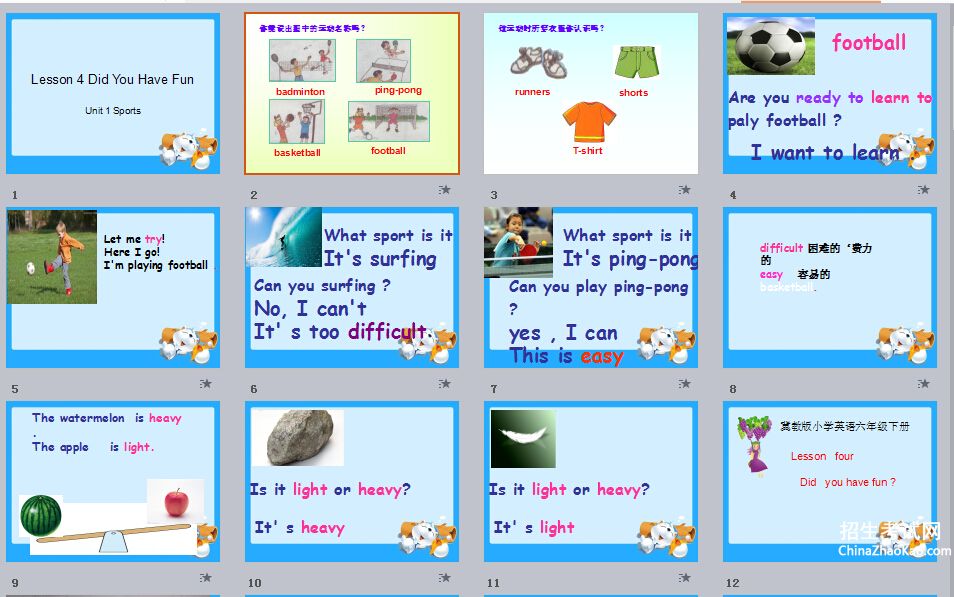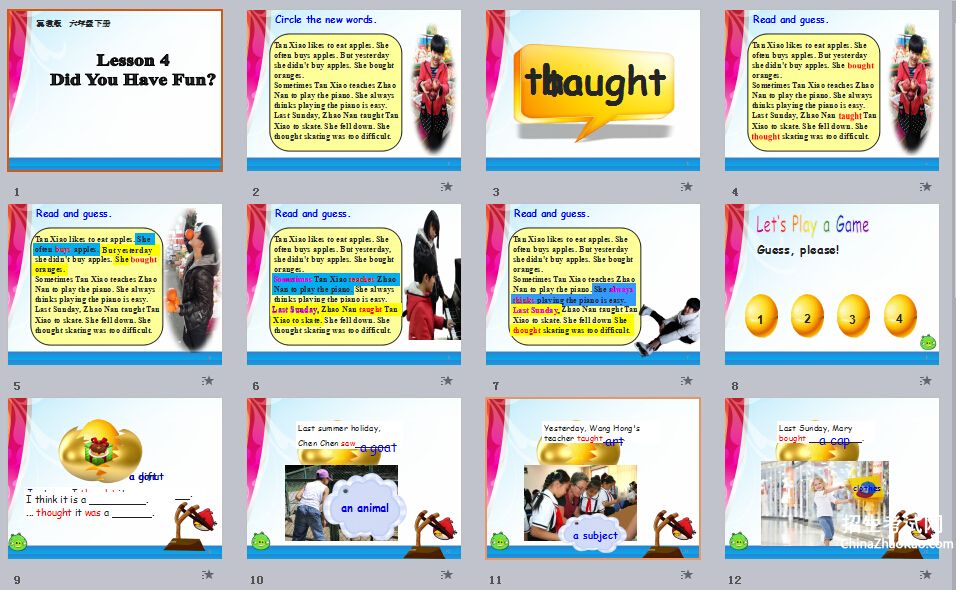【www.guakaob.com--小学英语】
Lesson 4 Did You Have Fun?
教学背景分析
1. 教学内容分析
本课是冀教版小学英语六年级下册第一单元第四课。本单元以运动为主题,讲述了李明在加拿大和好朋友珍妮、丹尼一起参加体育锻炼时发生的一连串趣事儿。通过前三课的学习,学生学会了一些描述运动项目和运动服饰及用品的词汇,同时,学习了一些与运动相关的情景和对话。本课就是李明和珍妮在回忆开心的一天,以相互教对方打球为话题展开的,其中穿插了丹尼在运动过程中因学习打球而受伤的小故事。学生通过学习本课,能够对比一般现在时和一般过去时,并加强对一般过去时的理解和应用。
2. 学习者分析
本课所面对的是小学六年级学生,年龄约12岁。他们活泼好动,想象力丰富,经过近四年的英语学习,绝大部分学生在学习英语时能做到:善于倾听、积极模仿、敢于开口、勇于实践。并且具备了一定的观察、朗读、模仿能力。 教学目标
1. 知识与能力目标
(1)能听懂、会说、认读单词:bought,taught,thought,player,fun,each other。
(2)能够对比区分一般现在时和一般过去时两种时态。能在真实的语境中运用动词过去式表述自己曾经做过什么,并用简单的语句写下来。
(3)能在老师的指导下听懂录音材料,并做出正确判断。
(4)能唱本课的英文歌曲What Did You Do?
2. 情感态度目标
(1)能够乐于感知并积极尝试使用英语,表达中不怕出错。
(2)能在英语歌曲的演唱中体会学习英语的乐趣。
(3)积极参与各种课堂学习活动,能在小组活动中积极与他人合作,交流分享,相互帮助,共同完成学习任务。
3. 学习策略目标
(1)在进行听力练习前,能够快速阅读题目,为顺利完成听力练习做好铺垫。
(2)能在课堂交流中注意倾听,积极思考,主动探究,善于对比发现一般现在时和一般过去时的规律,运用两种时态进行英语表达。
(3)在小组活动中遇到困难时能够主动向同学或老师请教。
教学准备
板书,课件,活动用纸
教学过程
I. Greeting and Warm-up
T: I’m very happy to see you. How are you today?
S: …
T: How’s the weather?
S: …
T: It’s snowy and cold. But I like cold days, because I can ski. I often ski. What do you often do?
S1: …
S2: …
T: Did you … yesterday?
S: …
T: What did you do yesterday, Tan Xiao?
Tan Xiao: …
T: Let’s read the passage about Tan Xiao and know more about her.
(设计意图:教师以学生的日常生活作为切入点,快速进入主题。通过自由交谈帮助学生回忆一般现在时和一般过去时,旨在对比中进一步学习和区分一般现在时、一般过去时两种时态,为后面的交际和写作教学做好铺垫。)
II. New Concepts
Step 1: Circle the New Words
T: Please take out your paper. Read the first part. Circle the new words quickly. When you finish, put your hands up.
【贴近学生生活的自编文本】:

Tan Xiao likes to eat apples. She often buys apples. But yesterday she didn’t buy
apples. She bought oranges. Sometimes Tan Xiao teaches Zhao Nan to play the piano. She always thinks playing the piano is easy. Last Sunday, Zhao Nan taught Tan Xiao to skate. Tan Xiao fell down. She thought skating was too difficult.
教师引导学生先解决除bought, thought, taught以外的单词,然后教师请学生关注幻灯片中逐一出示的三个重点单词。通过以旧代新的方式,解决这三个词的发音。并通过观察PPT中这三个单词的书写,注意这三个单词书写间词形的变化。
(设计意图:为贴近学生生活,教师大胆尝试自己创编文本。选取学生作为主人公,激发了学生学习的积极性。在第一遍自读文本时,教师让学生初步感知文本,快速圈出生词,锻炼了学生速读的能力。)
Step 2: New Concepts
T: Read and guess the meaning of the red words according to the passage.
T: Do you remember bought? What’s the meaning?
S: …
T: How do you know that?
S: Tan Xiao often buys apples. Yesterday she bought oranges.【lesson4did,you,have,fun】
T: All right. Please look at the blackboard.
(教师板书这两句: She often buys apples. Yesterday she bought oranges.) T: Let’s read it.
T: Why do we use “buys” here? And why do we use “bought” there?
S: …
对比teach—taught, think—thought两组方式如上。
(设计意图:教师在创编的文本中对比呈现一般现在时和一般过去时两种时态,达到让学生复习旧知,学习新知的目的。教师在本环节中,充分发挥了学生自主学习的能力。争取让学生在对比中掌握新知,做到学以致用。)
Step 3: Game
T: Tan Xiao thought skating was too difficult. I agree with her. Because I can’t stand up on the ice. I think skating is difficult, too. But I can play computer games very well. Let play a game. OK?
T: Guess what’s in the eggs.
1. The first egg: thought
T: Look, there is a gift. Guess, what’s in the box? Two students in a pair, please talk with each other.
T: What did you think was in the box?
S: I thought it was a T: What did your partner think?
S: ...thought it was a 2. The second egg: saw
T: Last summer holiday, Chen Chen went to the zoo. Can you guess what he saw?
3. The third egg: taught
Yesterday, Wang Hong’s teacher taught
4. The fourth egg: bought
Last Sunday, Mary went to the clothes shop. Can you guess what she bought?
(设计意图:本游戏环节,教师设计了一个愤怒小鸟砸蛋的游戏,当蛋砸开后,教师鼓励全班同学大胆猜测,用目标语言表达自己的观点。砸蛋游戏通过真实的情境,既巩固了知识,又加强了学生学习英语的兴趣。)
Step 4: Listen to the text then check.
T: Did you have fun?
Ss: Yes.
T: Look, who’s coming?
Ss: Jenny and Li Ming.
T: Did they have fun? They are talking with Jenny’s mother. Let’s listen and check. First, please read the questions quickly.
T: Do you know “each other”?
Last week, Tan Xiao taught Zhao Nan to play the piano. Last Sunday, Zhao Nan taught Tan Xiao to skate. They taught each other.(老师配合肢体语言帮助孩子理解)
T: Listen the second time.
T: Who wants to show your answers.
(设计意图:本环节意在锻炼学生的听力。教师让学生在听前快速阅读题目,并解决了each other这个三会单词,为学生的听力扫除了障碍。在核对答案的环节,如果答案是F,老师可以追问学Why? 假如学生答不上来,教师即有针对性的只播放关于这个问题相对应的课文内容,让学生从中找到答案。使学生实实在在地听懂并理解课文内容。)
Step 5: Song
T: Let’s sing a song to relax. The first time, just listen, please.
T: Try to sing.
T: Let’s sing together. Stand up. Loudly, please.
(设计意图:在进行了紧张的听力练习后,教师为学生准备了一首欢快活泼的英文歌曲。学生在演唱歌曲的同时,再一次复现了本课重点——过去式,学生最后能水到渠成跟唱,增强了孩子学习英语的自信心。)
Step 6: Watch, talk and write.
T: Jenny and Li Ming went to a shop. They bought a new ball. They were very happy. Last Sunday, I had fun. What did I do? Let’s watch.
T: I cleaned my house. I read my book. I made dinner for my family. What did you do last Sunday? Please talk with each other. Say as many sentences as you can. Try to remember your partner’s answer. These words may help you.
T: Who wants to show? What did you do last Sunday? Listen carefully and remember what he did.【lesson4did,you,have,fun】
Ss: …
T: We did a lot things last Sunday. Please write them down on your paper.
T: Check the passages with your partner. If it’s right, please tick.
T: Change back.
(教师拿出一份学生相互批改过的小作文展示在实物投影上。Who can help him correct? 改正后提示全班同学,看看有没有类似的错误。并请这位同学读一读展示在实物投影上的作文。)

(设计意图:教师以自己的生活为原形,引导学生在二人小组内,用尽可能多的句子,说一说自己上周日做过的事情,并试着记住对方上周做过的事情,然后教
Lesson 4 Did You Have Fun?
教学背景分析
1. 教学内容分析
本课是冀教版小学英语六年级下册第一单元第四课。本单元以运动为主题,讲述了李明在加拿大和好朋友珍妮、丹尼一起参加体育锻炼时发生的一连串趣事儿。通过前三课的学习,学生学会了一些描述运动项目和运动服饰及用品的词汇,同时,学习了一些与运动相关的情景和对话。本课就是李明和珍妮在回忆开心的一天,以相互教对方打球为话题展开的,其中穿插了丹尼在运动过程中因学习打球而受伤的小故事。学生通过学习本课,能够对比一般现在时和一般过去时,并加强对一般过去时的理解和应用。
2. 学习者分析
本课所面对的是小学六年级学生,年龄约12岁。他们活泼好动,想象力丰富,经过近四年的英语学习,绝大部分学生在学习英语时能做到:善于倾听、积极模仿、敢于开口、勇于实践。并且具备了一定的观察、朗读、模仿能力。 教学目标
1. 知识与能力目标
(1)能听懂、会说、认读单词:bought,taught,thought,player,fun,each other。
(2)能够对比区分一般现在时和一般过去时两种时态。能在真实的语境中运用动词过去式表述自己曾经做过什么,并用简单的语句写下来。
(3)能在老师的指导下听懂录音材料,并做出正确判断。
(4)能唱本课的英文歌曲What Did You Do?
2. 情感态度目标
(1)能够乐于感知并积极尝试使用英语,表达中不怕出错。
(2)能在英语歌曲的演唱中体会学习英语的乐趣。
(3)积极参与各种课堂学习活动,能在小组活动中积极与他人合作,交流分享,相互帮助,共同完成学习任务。
3. 学习策略目标
(1)在进行听力练习前,能够快速阅读题目,为顺利完成听力练习做好铺垫。
(2)能在课堂交流中注意倾听,积极思考,主动探究,善于对比发现一般现在时和一般过去时的规律,运用两种时态进行英语表达。
(3)在小组活动中遇到困难时能够主动向同学或老师请教。
教学准备
板书,课件,活动用纸
教学过程
I. Greeting and Warm-up
T: I’m very happy to see you. How are you today?
S: …
T: How’s the weather?
S: …
T: It’s snowy and cold. But I like cold days, because I can ski. I often ski. What do you often do?
S1: …
S2: …
T: Did you … yesterday?
S: …
T: What did you do yesterday, Tan Xiao?
Tan Xiao: …
T: Let’s read the passage about Tan Xiao and know more about her.
(设计意图:教师以学生的日常生活作为切入点,快速进入主题。通过自由交谈帮助学生回忆一般现在时和一般过去时,旨在对比中进一步学习和区分一般现在时、一般过去时两种时态,为后面的交际和写作教学做好铺垫。)
II. New Concepts

Step 1: Circle the New Words
T: Please take out your paper. Read the first part. Circle the new words quickly. When you finish, put your hands up.
【贴近学生生活的自编文本】:
Tan Xiao likes to eat apples. She often buys apples. But yesterday she didn’t buy
apples. She bought oranges. Sometimes Tan Xiao teaches Zhao Nan to play the piano. She always thinks playing the piano is easy. Last Sunday, Zhao Nan taught Tan Xiao to skate. Tan Xiao fell down. She thought skating was too difficult.
教师引导学生先解决除bought, thought, taught以外的单词,然后教师请学生关注幻灯片中逐一出示的三个重点单词。通过以旧代新的方式,解决这三个词的发音。并通过观察PPT中这三个单词的书写,注意这三个单词书写间词形的变化。
(设计意图:为贴近学生生活,教师大胆尝试自己创编文本。选取学生作为主人公,激发了学生学习的积极性。在第一遍自读文本时,教师让学生初步感知文本,快速圈出生词,锻炼了学生速读的能力。)
Step 2: New Concepts
T: Read and guess the meaning of the red words according to the passage.
T: Do you remember bought? What’s the meaning?
S: …
T: How do you know that?【lesson4did,you,have,fun】
S: Tan Xiao often buys apples. Yesterday she bought oranges.
T: All right. Please look at the blackboard.
(教师板书这两句: She often buys apples. Yesterday she bought oranges.) T: Let’s read it.
T: Why do we use “buys” here? And why do we use “bought” there?
S: …
对比teach—taught, think—thought两组方式如上。
(设计意图:教师在创编的文本中对比呈现一般现在时和一般过去时两种时态,达到让学生复习旧知,学习新知的目的。教师在本环节中,充分发挥了学生自主学习的能力。争取让学生在对比中掌握新知,做到学以致用。)
Step 3: Game
T: Tan Xiao thought skating was too difficult. I agree with her. Because I can’t stand up on the ice. I think skating is difficult, too. But I can play computer games very well.
Let play a game. OK?
T: Guess what’s in the eggs.
1. The first egg: thought
T: Look, there is a gift. Guess, what’s in the box? Two students in a pair, please talk with each other.
T: What did you think was in the box?
S: I thought it was a T: What did your partner think?
S: ...thought it was a 2. The second egg: saw
T: Last summer holiday, Chen Chen went to the zoo. Can you guess what he saw?
3. The third egg: taught
Yesterday, Wang Hong’s teacher taught
4. The fourth egg: bought
Last Sunday, Mary went to the clothes shop. Can you guess what she bought?
(设计意图:本游戏环节,教师设计了一个愤怒小鸟砸蛋的游戏,当蛋砸开后,教师鼓励全班同学大胆猜测,用目标语言表达自己的观点。砸蛋游戏通过真实的情境,既巩固了知识,又加强了学生学习英语的兴趣。)
Step 4: Listen to the text then check.
T: Did you have fun?
Ss: Yes.
T: Look, who’s coming?
Ss: Jenny and Li Ming.
T: Did they have fun? They are talking with Jenny’s mother. Let’s listen and check. First, please read the questions quickly.
T: Do you know “each other”?
Last week, Tan Xiao taught Zhao Nan to play the piano. Last Sunday, Zhao Nan taught Tan Xiao to skate. They taught each other.(老师配合肢体语言帮助孩子理解)
T: Listen the second time.
上一篇:小学四年级英语教学目标
下一篇:国培总结英语